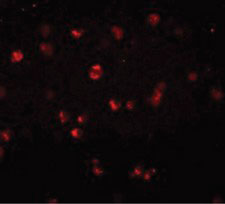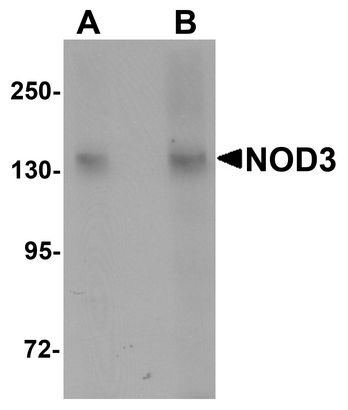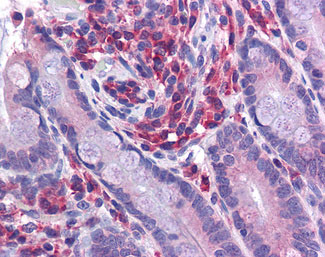NOD3 / NLRC3 Antibody (Internal)
Rabbit Polyclonal Antibody
- SPECIFICATION
- CITATIONS
- PROTOCOLS
- BACKGROUND

Application
| WB, IHC-P, IF, E |
|---|---|
| Primary Accession | Q7RTR2 |
| Reactivity | Human, Mouse, Rat |
| Host | Rabbit |
| Clonality | Polyclonal |
| Calculated MW | 115kDa |
| Dilution | IHC-P (5 µg/ml), WB (1-2 µg/ml), |
| Gene ID | 197358 |
|---|---|
| Other Names | Protein NLRC3, CARD15-like protein, Caterpiller protein 16.2, CLR16.2, Nucleotide-binding oligomerization domain protein 3, NLRC3, NOD3 |
| Target/Specificity | Human NLRC3 |
| Reconstitution & Storage | Short term 4°C, long term aliquot and store at -20°C, avoid freeze thaw cycles. Store undiluted. |
| Precautions | NOD3 / NLRC3 Antibody (Internal) is for research use only and not for use in diagnostic or therapeutic procedures. |
| Name | NLRC3 |
|---|---|
| Synonyms | NOD3 |
| Function | Negative regulator of the innate immune response (PubMed:15705585, PubMed:22863753, PubMed:25277106). Attenuates signaling pathways activated by Toll-like receptors (TLRs) and the DNA sensor STING/TMEM173 in response to pathogen-associated molecular patterns, such as intracellular poly(dA:dT), but not poly(I:C), or in response to DNA virus infection, including that of Herpes simplex virus 1 (HSV1) (By similarity) (PubMed:22863753). May affect TLR4 signaling by acting at the level of TRAF6 ubiquitination, decreasing the activating 'Lys-63'-linked ubiquitination and leaving unchanged the degradative 'Lys-48'-linked ubiquitination (PubMed:22863753). Inhibits the PI3K-AKT-mTOR pathway possibly by directly interacting with the posphatidylinositol 3-kinase regulatory subunit p85 (PIK3R1/PIK3R2) and disrupting the association between PIK3R1/PIK3R2 and the catalytic subunit p110 (PIK3CA/PIK3CB/PIK3CD) and reducing PIK3R1/PIK3R2 activation. Via its regulation of the PI3K-AKT-mTOR pathway, controls cell proliferation, predominantly in intestinal epithelial cells (By similarity). May also affect NOD1- or NOD2-mediated NF-kappa-B activation (PubMed:25277106). Might also affect the inflammatory response by preventing NLRP3 inflammasome formation, CASP1 cleavage and IL1B maturation (PubMed:25277106). |
| Cellular Location | Cytoplasm |

Thousands of laboratories across the world have published research that depended on the performance of antibodies from Abcepta to advance their research. Check out links to articles that cite our products in major peer-reviewed journals, organized by research category.
info@abcepta.com, and receive a free "I Love Antibodies" mug.
Provided below are standard protocols that you may find useful for product applications.
Background
May modulate T-cell activation. Decreases the transcription of genes that are normally up-regulated after T-cell stimulation. Delays degradation of NFKBIA/IKBA.
References
Inohara N.,et al.Nat. Rev. Immunol. 3:371-382(2003).
Conti B.J.,et al.J. Biol. Chem. 280:18375-18385(2005).
Jikuya H.,et al.DNA Res. 10:49-57(2003).
Jikuya H.,et al.Submitted (JUL-2002) to the EMBL/GenBank/DDBJ databases.
Huse K.,et al.Submitted (APR-2002) to the EMBL/GenBank/DDBJ databases.
If you have used an Abcepta product and would like to share how it has performed, please click on the "Submit Review" button and provide the requested information. Our staff will examine and post your review and contact you if needed.
If you have any additional inquiries please email technical services at tech@abcepta.com.













 Foundational characteristics of cancer include proliferation, angiogenesis, migration, evasion of apoptosis, and cellular immortality. Find key markers for these cellular processes and antibodies to detect them.
Foundational characteristics of cancer include proliferation, angiogenesis, migration, evasion of apoptosis, and cellular immortality. Find key markers for these cellular processes and antibodies to detect them. The SUMOplot™ Analysis Program predicts and scores sumoylation sites in your protein. SUMOylation is a post-translational modification involved in various cellular processes, such as nuclear-cytosolic transport, transcriptional regulation, apoptosis, protein stability, response to stress, and progression through the cell cycle.
The SUMOplot™ Analysis Program predicts and scores sumoylation sites in your protein. SUMOylation is a post-translational modification involved in various cellular processes, such as nuclear-cytosolic transport, transcriptional regulation, apoptosis, protein stability, response to stress, and progression through the cell cycle. The Autophagy Receptor Motif Plotter predicts and scores autophagy receptor binding sites in your protein. Identifying proteins connected to this pathway is critical to understanding the role of autophagy in physiological as well as pathological processes such as development, differentiation, neurodegenerative diseases, stress, infection, and cancer.
The Autophagy Receptor Motif Plotter predicts and scores autophagy receptor binding sites in your protein. Identifying proteins connected to this pathway is critical to understanding the role of autophagy in physiological as well as pathological processes such as development, differentiation, neurodegenerative diseases, stress, infection, and cancer.




